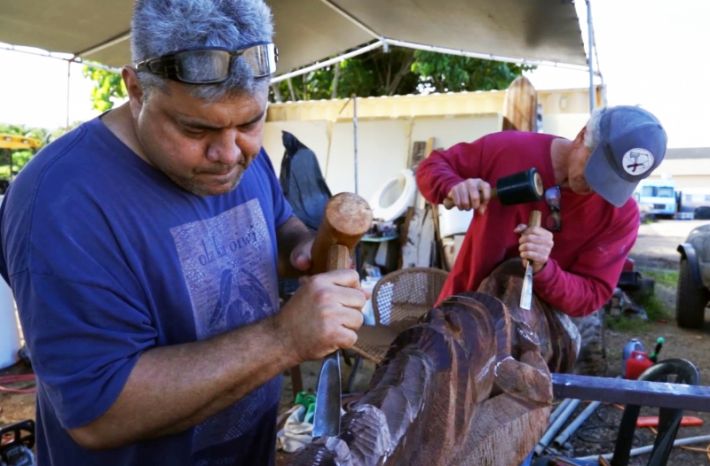This mo‘olelo is part of Kūkahekahe – Cultural Conversations – featuring personal experiences and insights from faculty, staff and friends about compelling cultural happenings within the KS organization, throughout the Hawaiian Islands, and across the larger Pacific and global communities.
Raised in Lāʻie, Jared Pere carved a copy of a New Zealand 10 cent coin after receiving his first carving chisel set from an uncle when he was just seven years old. Then in 1978, he began learning the intricacies of carving from his uncle Barney Epanaia Christy of the Polynesian Cultural Center. Today, Jared continues to pass on his knowledge and skills to the next generation as foreman of the Polynesian Cultural Center’s Carving Department.
Born to Māori parents, Jared grew up in Hawaiʻi and Aotearoa. He attended Kahuku High School and Brigham Young University. He graduated with a B.A. in Māori Visual Art and Design from the esteemed Toihoukura Māori Visual Arts School in Gisborne which helped to form his foundation and knowledge in traditional Māori art design.
“When carving an image for an individual, you want to portray the mana of the person and the mana of their ancestors,” Pere said. “That is the only way I see it, that’s the way I was taught.”
His skill in wood carving led him to other mediums such as clay and foam in his artwork. He spent several years in Los Angeles where he sculpted large-scale props in the movie industry.
In 2018, Kamehameha Schools approached the Polynesian Cultural Center with a proposal for Pere to collaborate with KS Cultural Specialist and Kaʻiwakīloumoku carver Kumulaʻau Sing KSK’89 to carve a poupou, an ancestral post, as a tribute to esteemed Māori navigator and guiding elder of Kamehameha’s ʻAha Moananuiākea Pacific Consortium, Sir Hector Hekenukumai Ngaiwi Busby.
Pere agreed; the opportunity was special because he had met Busby years earlier in Lahaina where the elder had carved a waka taua, Māori war canoe, for the Celebration of Canoes event. This new collaboration would help to strengthen the KS-PCC relationship and honor Busby for his contributions to waka building and wayfinding in Aotearoa.
In just a few weeks’ time, working around the clock, Pere and Sing were able to carve from legacy ʻōhiʻa wood gifted from the Polynesian Cultural Center, the beautiful Mauipāmamaoiki, “Young offshoot of Māui that touches great distances.” It was modeled after its original larger counterpart, Māuipamamao, which currently stands at Te Tii Marae in Waitangi where it has represented the Ngāti Ruawāhia heritage of Hōkūleʻa and Kamehameha Schools since its dedication in 1992.
Pere and Sing’s recent creation has its own special distinction. It was presented in ceremony as a taonga, a treasure, to mark the opening of Whetū Mārama at Aurere, Aotearoa in December of 2018. The new “house of learning” is part of a larger complex currently under construction called Sir Hekʻs Kupe Waka Centre. Upon its completion in early 2022, it will be the sister centre of our own Kaʻiwakīloumoku Hawaiian Cultural Center. It is our hope that Māuipāmamaoiki will stand guard there, representing our Hawaiian Ngāti Ruawāhia heritage, for many years to come.
“It was a great honor for me to help carve the image for ʻAnakala Hector and to collaborate and meet people from Kamehameha Schools and Polynesian Voyaging Society - just to be a part of that group,” Pere said. “I really like people who enjoy and appreciate the arts. I have met people in the past who maybe don’t have such an appreciation. The difference is very telling. But always, I go back to the things that I learned from my Uncle Epanaia about using our skills and talents that we are blessed with to make the world better - connecting with people. Everybody has a history, everybody has a whakapapa with ancestors and amazing stories to be told. I really enjoy being a part of that and just helping out.”
Pere continues to find inspiration through carving, which allows him to learn about his ancestors and tell their stories through his work. “I can always connect back to my Māori ancestors because I can create thousands of designs to tell their stories, and not just theirs but also of my Irish, French, Scottish, and Welsh ancestors too,” he said. Pere continues his work in the community and abroad, inspiring others to connect with their ancestors and share their stories through art, one piece at a time.
As community health conditions improve and safe social interactions return, Pere and Sing are committed to advancing partnerships and initiatives that promote traditional carving among our youth.

Carvers Sing and Pere hard at work. The Ngāti Ruawāhia tribal heritage of Kamehameha Schools was elevated and honored through Pere’s extraordinary carving skills which connect him to his Māori ancestors.

Hoʻokahua Cultural Specialist Makaʻala Rawlins (right) and Performing Arts teacher Kaleo Trinidad KSK’93 (off camera, left) gird Māuipāmaomao with a malo in the Kupe Waka Centre, in Aurere, Aotearoa.
TAGS
hookahua,
kaiwakiloumoku,
kūkahekahe,
cultural conversations,
aha moananuiākea pacific consortium,
hawaiian culture,
community partnerships
CATEGORIES
Kaipuolono Article, Regions, Themes, Culture, Community, Hawaii Newsroom, KS Hawaii Home, Kapalama Newsroom, Kapalama Home, Maui Newsroom, KS Maui Home, Newsroom, Campus Programs, Hawaii, Kapalama, Maui, Community Education, Department News
Print with photos
Print text only










